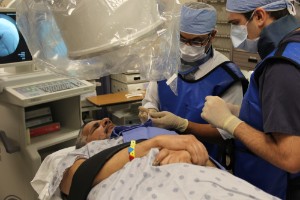
Physiatrists affiliated with TIRR Memorial Hermann’s Orthopedic/Multiple Trauma Program help patients with complex musculoskeletal injuries recover from trauma. The program is led by Jacob Joseph, MD, clinical chief of neuromuscular rehabilitation, clinical chief of orthopedic/trauma rehabilitation and vice chair for clinical operations in the department of Physical Medicine and Rehabilitation at McGovern Medical School at UTHealth.
“People who suffer traumatic injuries as a result of accidents may have multiple fractures that require surgery and acute care,” says Dr. Joseph, an assistant professor in the department. “After their initial treatment, many have severe functional limitations in their ability to perform daily activities. These people may benefit from therapy with a multidisciplinary rehabilitation team that helps them regain flexibility and strength in the context of function.”
Beginning rehabilitation early can help speed recovery, but for many injured patients physical therapy may be extremely painful during the first weeks after injury.
“TIRR Memorial Hermann provides inpatients with seven meaningful days of therapy,” says interventional pain management specialist Ajai Sambasivan, MD, an assistant professor of physical medicine and rehabilitation at McGovern Medical School at UTHealth. “If I went to the gym seven days a week, I would likely have very sore muscles. Inpatient rehabilitation is often more intensive than our day-to-day recreational exercise routines. Generally, I’m very conservative in my use of injections for pain, however; I make an exception for inpatients beginning rehabilitation. I believe there is a window of opportunity when targeted interventions can be combined with therapy for synergistic benefit. If we time and choose our interventions appropriately, patients can make great progress in therapy.”
Physical therapists often work on improving range of motion, muscle tightness and strengthening weak muscles, which may take several visits. Certain injections can jumpstart the process by rapidly improving the pain that limits range of motion, dramatically augmenting an individual’s progress.
“When a muscle hurts, a patient can’t strengthen it or engage it completely as a defense mechanism to prevent further injury. However, directed interventions, such as a trigger point injections, might temporarily help the pain to facilitate better activation of the muscle,” Dr. Sambasivan says.
It’s not uncommon for people with neurologic injuries to adapt and use their muscles for different functions. For instance, an individual with paraplegia might use the rotator cuff muscles for mobility in a manual wheelchair. This may cause abnormal wear and tear on shoulder structures.
“If pain limits such a patient’s ability to function, we might recommend directed therapy or interventions to improve function,” he says. “There are adverse effects to any medication we use, whether oral or injected, and most adverse effects are dose dependent. We try to use image guidance with X-ray or ultrasound to target the specific area of damage when performing an intervention, which allows us to administer a much smaller dose of medication.”
Dr. Sambasivan joined UTHealth and the TIRR Memorial Hermann medical staff after completing his fellowship in musculoskeletal and interventional pain management at Rutgers University in New Jersey. His primary focus is diagnosing and managing musculoskeletal and spine pain with therapy, bracing, medications, diagnostic testing and image-guided interventional procedures.